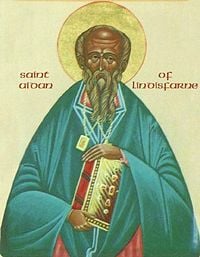Saint Aidan
- For other uses, see Saint Aidan (disambiguation).
| Saint Aidan of Lindisfarne | |
|---|---|
| Bishop | |
| Died | 31 August 651 in Parish Churchyard, Bamburgh, Northumberland |
| Venerated in | Roman Catholic Church, Eastern Orthodox Church, Anglican Communion, Lutheran Church |
| Major shrine | originally Lindisfarne Abbey, Northumberland; later disputed between Iona Abbey & Glastonbury Abbey (all destroyed). |
| Feast | 31 August (Roman Catholic Church, Anglican Communion), June 9 (Lutheran Church) |
| Attributes | Monk holding a flaming torch; stag |
| Patronage | Northumbria; Firefighters |
- "Augustine was the Apostle of Kent, but Aidan was the Apostle of the English." - Bishop Lightfoot
Saint Aidan of Lindisfarne, the Apostle of Northumbria (died 651), was the founder and first bishop of the monastery on the island of Lindisfarne in England. A Christian missionary, he is credited with restoring Christianity to Northumbria. Aidan is the anglified form of the original Old Irish Áedán.
Life
An Irishman, possibly born in Connacht, Aidan was a monk at the monastery on the island of Iona in Scotland.
The Roman Empire had spread Christianity into Britain, but due to its decline, paganism was seeing a resurgence in some parts. Oswald of Northumbria had been living at the Iona monastery as a king in exile since 616 C.E. There he converted to Christianity and was baptised. In 634 he gained the crown of Northumbria, and was determined to bring Christianity to the mostly pagan people there.
Owing to his past at Iona, he requested missionaries from that monastery instead of the Roman-backed monasteries in England. At first the monastery sent a new bishop named Corman, but he returned to Iona and reported that the Northumbrians were too stubborn to be converted. Aidan criticised Corman's methods and was soon sent as a replacement in 635.[1]
Aidan chose the island of Lindisfarne, close to the royal castle at Bamburgh, as his seat of his diocese. King Oswald, who spoke Irish, often had to translate for Aidan and his monks, who did not speak English at first. When Oswald died in 642, Aidan received continued support from King Oswine of Deira and the two became close friends.
An inspired missionary, Aidan would walk from one village to another, politely conversing with the people he saw and slowly interesting them in Christianity. According to legend, the king gave Aidan a horse so that he wouldn't have to walk, but Aidan gave the horse to a beggar. By patiently talking to the people on their own level Aidan and his monks slowly restored Christianity to the Northumbrian communities. Aidan also took in twelve English boys to train at the monastery, to ensure that the area's future religious leadership would be English.
In 651 a pagan army attacked Bamburgh and attempted to set its walls ablaze. According to legend, Aidan prayed for the city, after which the winds turned and blew the smoke and fire toward the enemy, repulsing them.
Aidan was a member of the Irish branch of Christianity instead of the Roman branch, but his character and energy in missionary work won him the respect of Pope Honorius I and Felix of Dunwich.
Aidan's friend Oswine of Deira was murdered in 651. Twelve days later Aidan died, on August 31, in the 17th year of his episcopate.[1] He had become ill while at the Bamburgh castle and died leaning against the wall of the local church.
The monastery he founded grew and helped found churches and other monasteries throughout the area. It also became a centre of learning and a storehouse of scholarly knowledge. Saint Bede the Venerable would later write Aidan's biography and describe the miracles attributed to him. Saint Aidan's feast day is on 31 August.
| Religious titles | ||
|---|---|---|
| Preceded by: — |
Bishop of Lindisfarne 635 - 651 |
Succeeded by: Saint Finan |
See also
- St Aidan's College at the University of Durham is named for Aidan.
- St Aidan's Anglican Girls' School, a private school in Brisbane, Australia which claims its name from this patron saint.
- St Aidan's Church, Leeds contains celebrated mosaics by Frank Brangwyn illustrating the life of Aidan.
Notes
ReferencesISBN links support NWE through referral fees
- Attwater, Donald and Catherine Rachel John. The Penguin Dictionary of Saints. 3rd edition. New York: Penguin Books, 1993. ISBN 0-140-51312-4.
- Powicke, F. Maurice and E. B. Fryde Handbook of British Chronology 2nd. ed. London:Royal Historical Society 1961
External links
- Image of a modern statue of Aidan on Lindisfarne
- Biography on Aidan of Lindisfarne by David Golding (PDF)
- Irelandseye.com biography of Saint Aidan
- Saint Aidan of Lindisfarne by Reverend Canon Kate Tristram
- Early British Kingdoms: St. Aidan
- A History Of The Church (around the time of Aidan) by Philip Hughes
Credits
New World Encyclopedia writers and editors rewrote and completed the Wikipedia article in accordance with New World Encyclopedia standards. This article abides by terms of the Creative Commons CC-by-sa 3.0 License (CC-by-sa), which may be used and disseminated with proper attribution. Credit is due under the terms of this license that can reference both the New World Encyclopedia contributors and the selfless volunteer contributors of the Wikimedia Foundation. To cite this article click here for a list of acceptable citing formats.The history of earlier contributions by wikipedians is accessible to researchers here:
The history of this article since it was imported to New World Encyclopedia:
Note: Some restrictions may apply to use of individual images which are separately licensed.
